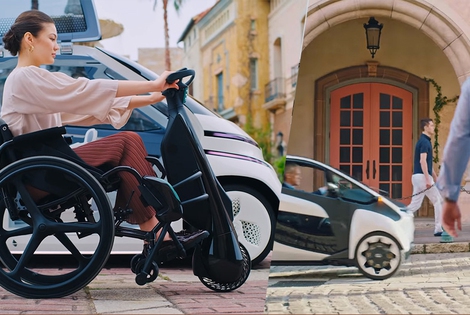
Milan has announced one of Europe’s most ambitious mobility schemes, known as Strade Aperte (open roads). Its goal is to reduce cars in phase 2 of the lockdown by increasing bike lanes and pedestrian areas.
2020, the year of the EU climate and energy package is round the corner. The climate package aims to reduce greenhouse gases emissions by 20%, improve energy efficiency by 20% and raise energy consumption from renewable sources to 20%. The average level of CO2 emissions of a new car must be limited to 95 grams and drivers
2020, the year of the EU climate and energy package is round the corner. The climate package aims to reduce greenhouse gases emissions by 20%, improve energy efficiency by 20% and raise energy consumption from renewable sources to 20%. The average level of CO2 emissions of a new car must be limited to 95 grams and drivers will be severely fined for every exceeding gram of CO2.
It is tough nut to crack for car manufacturers such as Lamborghini, which “only” makes high performance cars with very high CO2 emissions. Lamborghini committed to reduce CO2 emissions of car models present in its catalogue within 2015 (which is a big challenge, considering that Aventador reach 100 km/h in 2.8 seconds and has a maximum speed of 356 km/h). Will it be enough?
Step by step, after obtaining ISO 50001 certification in 2001, Lamborghini has committed in sustainable development and its now launching the new trigeneration and district heating plants, which are two among the main projects allowing it to get the CO2 neutral certificate (issued by DNV GL) aiming to reduce and compensate CO2 emissions generated the plant in Sant’Agata Bolognese, in the province of Bologna, within the end of 2015.
Sustainability is one of our company objectives and we subscribe to a strong undertaking of environmental responsibility towards our stakeholders and the area where the company operates,” said Stephan Winkelmann, Automobili Lamborghini President and CEO. “Our goal is to keep the plant CO2-neutral, even after the expansion that will take place in the upcoming years with the introduction of the third Lamborghini model,” told Winkelman, speaking about Urus, the first SUV (and the first hybrid car) ever produced by Lamborghini, which will be introduced to market in 2018.
The trigeneration plant allows producing electricity, heat and cooling using natural gas. It features an installed power of 1.2 MW and produces about 9,800 MWh per year. Within 2017, this plant will be powered by biogas. This will further reduce CO2 emissions to 5,600 tons per year.
As mentioned before, Lamborghini path towards sustainability during this years has also featured projects such as the photovoltaic power station stretching over 15,000 square metres, the cycle mobility development project in cooperation with the city of Bologna, but also Parco Lamborghini, open in Sant’Agata Bolognese in 2011, in cooperation with the universities of Bologna, Bolzano and Munich. Lamborghini also planted over 10,000 oaks on a surface of about 7 hectares in order to monitor and understand in the future the relations between density, forest productivity, the ability to capture CO2 and keeping the balance between biodiversity and climate.
Siamo anche su WhatsApp. Segui il canale ufficiale LifeGate per restare aggiornata, aggiornato sulle ultime notizie e sulle nostre attività.
![]()
Quest'opera è distribuita con Licenza Creative Commons Attribuzione - Non commerciale - Non opere derivate 4.0 Internazionale.
Milan has announced one of Europe’s most ambitious mobility schemes, known as Strade Aperte (open roads). Its goal is to reduce cars in phase 2 of the lockdown by increasing bike lanes and pedestrian areas.
Formula 1, the world’s most important auto racing championship, has decided to turn the page and aim for carbon neutrality with the support of its teams, drivers and the whole racing circus.
Toyota and LifeGate began telling the story of hybrid mobility back in 2006, now, on the road to the Tokyo 2020 Olympics, they’re still treading the path of sustainable mobility. Here are the main steps of the journey.
Germany’s first solar bicycle lane could be the prototype for the roads of the future. The photovoltaic tiles melt snow and ice, and are capable of absorbing noise.
The Vespa is back in an electric version. Production has just started and the first models can be reserved online starting from October.
The city of Utrecht, in the Netherlands, is home to a bridge for cycling and walking that stretches over roof garden of a Montessori school. This project enhances practicality and will allow families to bring children to school by bike, passing through green areas. Despite their functionality, bridges are often seen as an infrastructure that is
The Lego hair bike helmet is the latest Internet craze. For now it’s just a prototype but production on a large scale will probably start soon.
Just as fires often give way to new growth, after the Dieselgate scandal, which saw Volkswagen cheating on US emission rules, the German car manufacturer radically changed course, beginning to focus on sustainable mobility. The German car company aims to propose thirty zero-emission models and produce at least one million battery electric vehicles by 2025. An ambitious mission
Sustainable, two-wheel mobility is triumphing in Copenhagen. After years of investments, policies, and infrastructural changes, bikes now outnumber cars in the city centre. The website Copenhagenize has released data linked to the number of vehicles entering the city centre, which are monitored by the city’s administration on a daily basis. Last year, 265,700 bikes have entered







